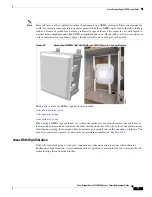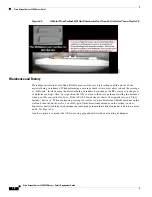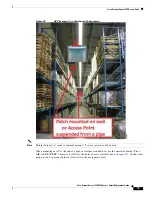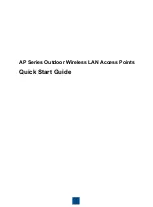
21
Cisco Aironet Series 2700/3700 Access Points Deployment Guide
Cisco Aironet Series 3700 Access Point
Access Point Spacing Recommendations
If you have a Wi-Fi device such as an AP and you are going to use another AP in the vicinity on a
different channel, it is recommended that you space each AP apart by approximately 6 Ft (2 meters).
Avoid clustering the APs or the antennas from different APs together because this could cause
degradation in performance. This recommended distance is based on the assumption that both devices
operate in the unlicensed band and do not transmit RF energy more than 23 dB–that is, 200 mW. If higher
power is used, space the APs farther apart.
Should you have other devices that transmit, especially if they operate in the same frequency ranges, for
example, frequency hopping legacy APs or other devices that operate close in frequency to those of the
AP (think below or above the 2.4 and 5 GHz band), you should consider moving or separating the devices
as far apart as can reasonably be done. After you have done this, check for interference by testing both
devices at the same time under heavy utilization (load) and then characterize each system independently
to see how much, if any, degradation exists.
Warning
In order to comply with FCC, EU, and EFTA RF exposure limits, antennas should be located at a
minimum of 7.9 inches (20 cm) or more from the body of all persons. See the installation guide under
declaration of conformity for more on this.
Installations in IDF Closets (Telecommunications or Other Electrical Equipment)
When installing APs near other electrical or telecommunications equipment, keep all wiring and metal
away from the antennas and avoid placing the antennas near electrical lines. Do not route wiring
electrical or Ethernet in the near field (6-15 inches) from the antenna. Try to refrain from installing the
AP in the electrical closet because the best place for the AP is as close to users as possible/practical. If
you have remote antenna cables from such a closet, you may be required to use Plenum rated cable (see
local fire/safety regulations for more on this).
Below are a few URLs for understanding interference:
http://www.cisco.com/en/US/prod/collateral/wireless/ps9391/ps9393/ps9394/prod_white_paper0900ae
cd807395a9_ns736_Networking_Solutions_White_Paper.html
http://www.cisco.com/en/US/prod/collateral/wireless/ps5678/ps10981/white_paper_c11-609300.html
Installations at Very High Altitudes
While not defined in the specification sheet for the AP 3600 and AP 3700, these APs passed functional
checks after a Non-Operational altitude test of 25C @ 15,000 Ft was performed. Additionally, they fully
passed a functional test during an operational altitude test of 40C @ 9,843 Ft.
All units in the test group were connected to at least one WLAN client and monitored for continual
operation passing traffic, while performing constant ping testing throughout the operational altitude test.
Installations Using a Common or Distributed Antenna System (DAS)
Due to the dual-band nature of the antenna system on the AP 3700 and AP 3600, along with key features
such as ClientLink beamforming, it is not recommended for deployments on DAS.
Customers wishing to integrate a Wi-Fi over DAS solution should understand that Cisco does not certify,
endorse, or provide RF support for Wi-Fi deployments over any DAS.
















































